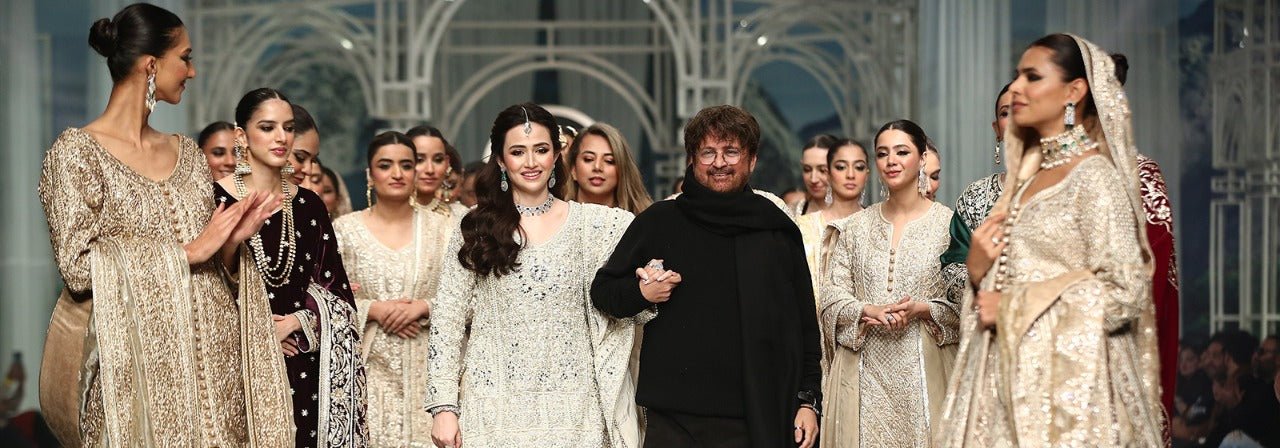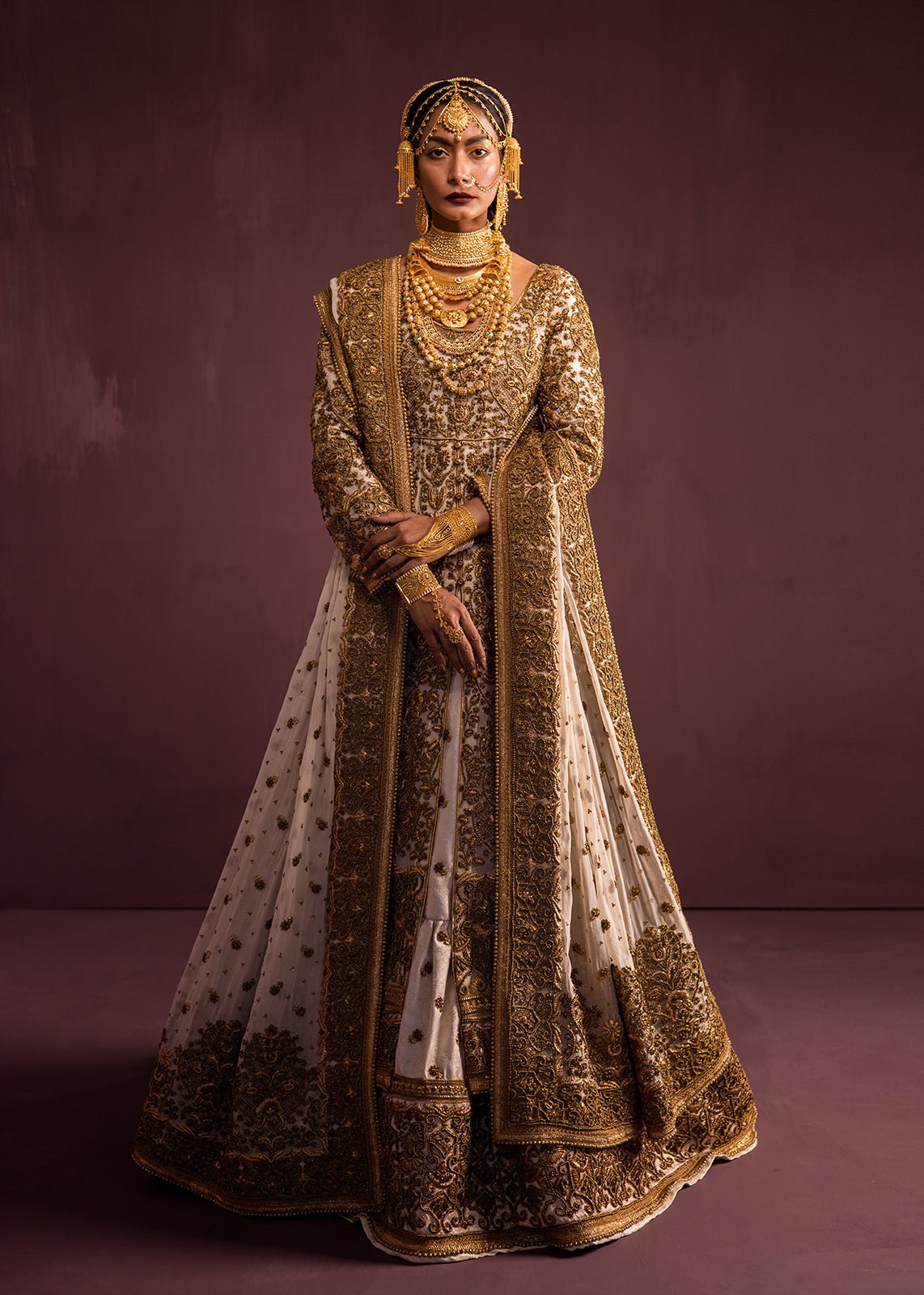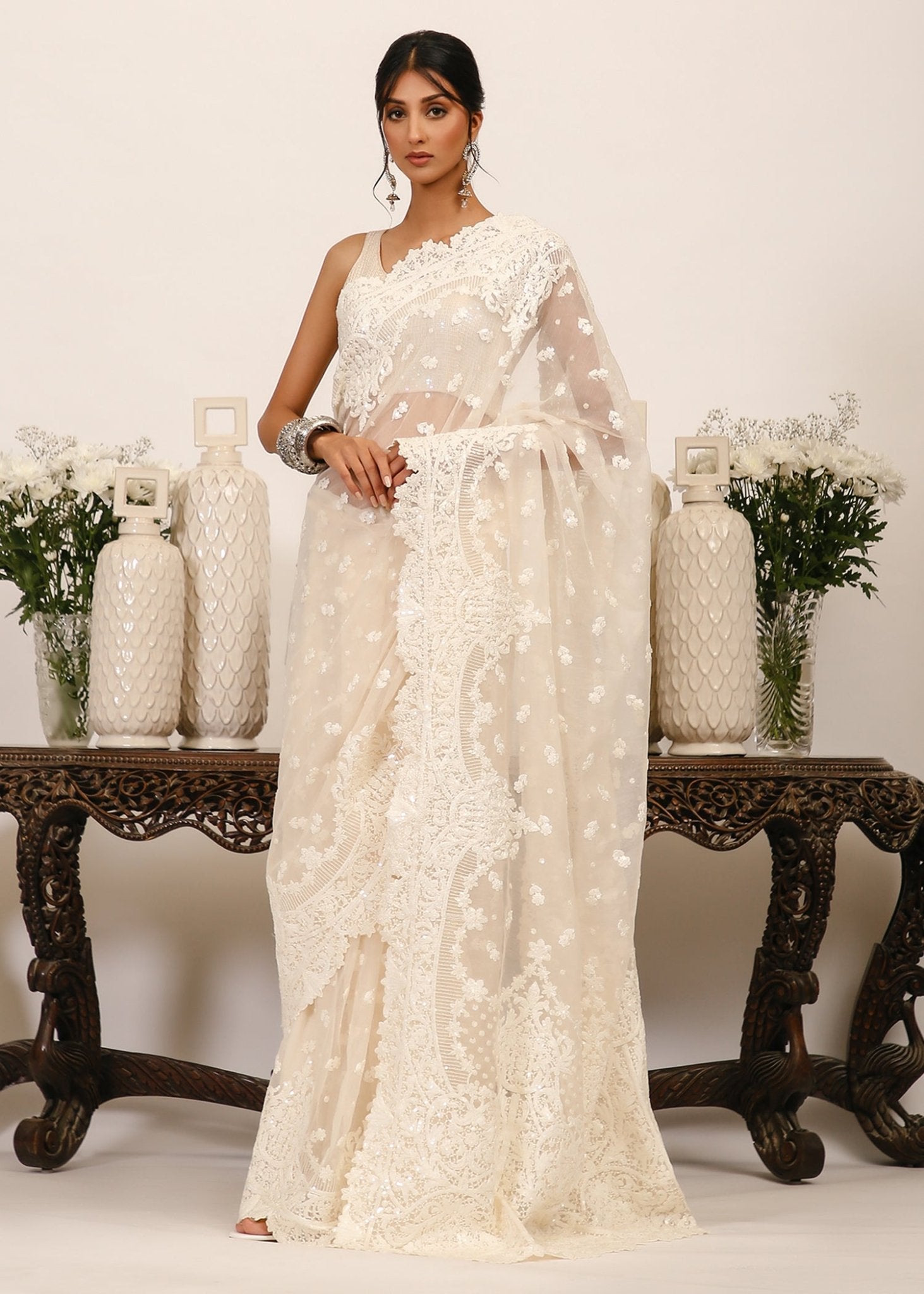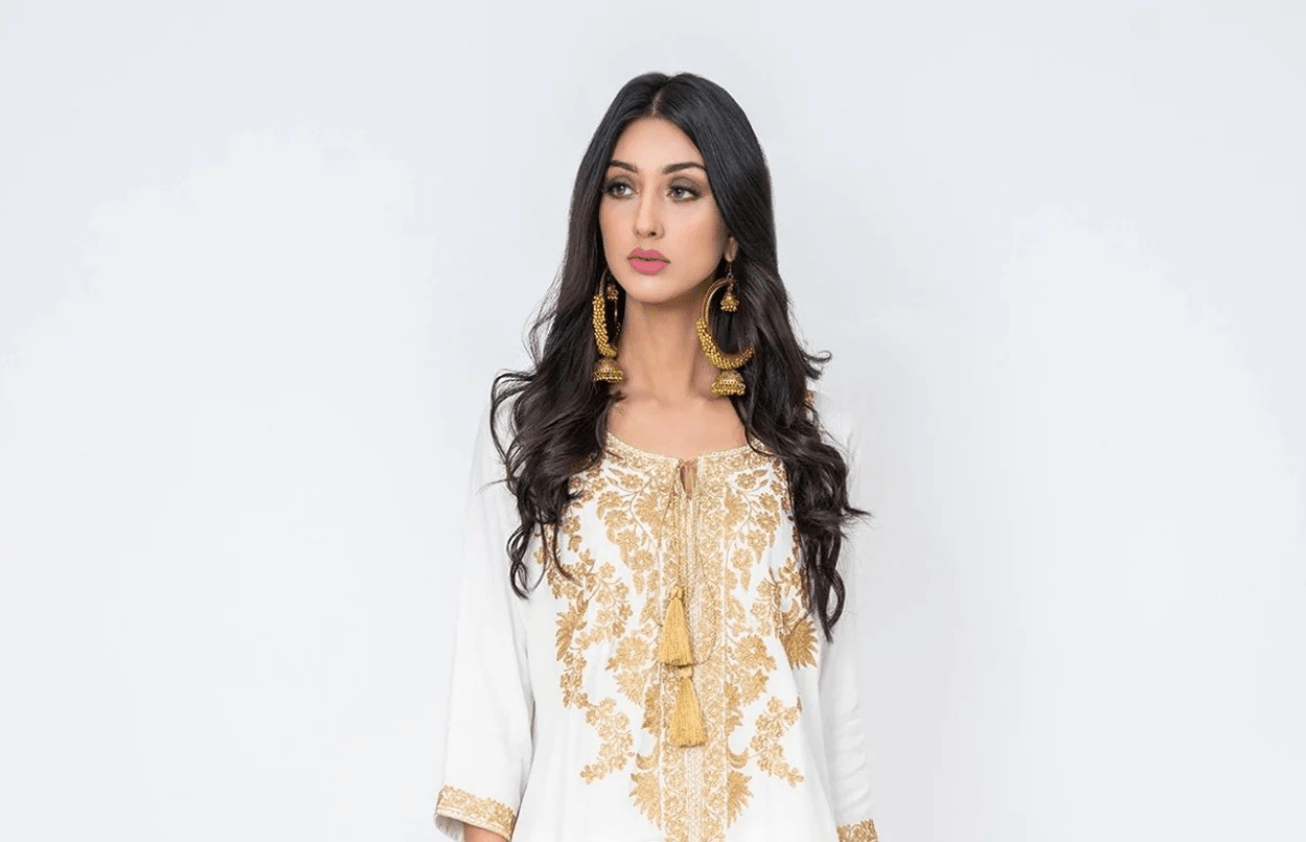Article: Dawn Interview RIZWAN BEYG AND HIS JAM

Dawn Interview RIZWAN BEYG AND HIS JAM
Written by Maliha Rehman
In Rizwan Beyg’s world, tiny stitches blend together and bloom into cheerful florals. Dainty threadwork winds over fabric to form paisleys. Truck-art colours get splattered with heavy spurts of bling. Dupattas come lined with thick borders. Jamawar is layered with a thousand hand-stitches that form arches, trellises, tiny flowers and clouds of stardust.
The hallmark of the finest designer ateliers is that they are symbolic of a certain vision, a certain world created by the designer. And as I step into Rizwan’s world — or rather, his flagship store in Karachi — I am swept away by the signature embroideries that I identify with him the most.
Rizwan, though, wants to lead me elsewhere.
Drawing my attention away from a lehnga which twinkles with a mix of gota and panni, he shows me a mannequin dressed in a wispy, pleated dress in basic off-white cotton. There are hidden zips tapering down the sides and pin-tucks on the back. There is no colour and there is not even a semblance of embroidery.
There are more designs along the same lines — dresses and short tunics all relying entirely on cuts and patterns. Rizwan tells me that there will be tan leather belts cinching the waistline and a range of leather handbags will accessorise the designs. And then, this March, the collection will be paraded down the runway at Colombo Fashion Week (CFW).
With more than three decades in the business, Rizwan Beyg is one amongst very few Pakistani designers who can turn his needle towards intricate bridal embroidery just as easily as he can use it to stitch together a minimalist cotton dress based on a fashion-forward silhouette. How does he view the seeming polar extremes of his creativity?

It’s very chic, very fashion-forward and, to be honest, while the artistry of Rizwan’s hand-embroideries cannot be denied, it’s refreshing to see a line-up relying entirely on cuts rather than a heady mix of colourful florals. It’s also a far cry from the whopping line-up of 52 fully embellished designs that I saw about a month ago, in Rizwan’s solo show at the Bridal Couture Week (BCW) in Lahore.
“I wanted to step away from the embroideries and create a capsule line where the stitching and the silhouette are focal points,” says Rizwan. “I have always envisioned the world as my oyster. I want to push myself further and dabble in different directions. If I can do this, then why not do that as well?”
The fact is, not all designers in Pakistan possess the experience and expertise to do this as well as that, whenever they please. Rizwan Beyg, with his more than three decades in the business, is one amongst very few who can turn his needle towards intricate handcraft just as easily as he can use it to stitch together a dainty cotton dress.
Nevertheless, like all designer ateliers across Pakistan, Rizwan’s store racks are chockful with embroidered collections. The mannequin in her cotton dress stands alone, with lehngas and farshi ghararas laden with embroidery forming the backdrop.
The sharp contrast leads me to ask him if he feels that design, including his own, is becoming repetitive and too commercial, aiming to appease a predominantly traditional market for wedding-wear rather than set trends?
Bread, butter, jam
“As a designer what do I want to do?” he queries. “I want to earn my bread and butter so that I can experiment with my jam!”
The bread and butter, of course, are the hand-embroidered creations while jam, at this point, constitutes the cotton capsule line created for Colombo.
Rizwan continues, “Fashion is a reflection of the times that we live in and the Pakistani woman of today wants to wear clothes that conceal rather than enhance her figure. People keep blaming designers for fixating on commerce, but no one turns around and points out that the onus is actually on the consumer.
“The consumer is limited by culture, religion, politics and a lack of confidence in her body. She doesn’t want to wear something that will flaunt her figure. I could create a little black dress but who is going to buy it, how will it be relevant to the country that I live in and the market that I cater to?
“I could either leave Pakistan and work in a sweatshop somewhere in Paris, or I could design pretty, embellished clothes for a clientele that appreciates my aesthetic. This is why lawn sells well. It is amorphous and has pretty flowers everywhere, and you don’t have to be gym-fit to wear it.
“This is why there will always be a demand for the farshi gharara or the kurta. I will make what the consumer wants because I want to earn a living. No one in their right mind can sustain a business based solely on creative, fashion-forward design.”
And yet, you’ve just shown me a line-up that is based on anglicised cuts and which accentuates the silhouette, I point out.
“I have only created this collection because I will be showing it on an international platform,” says Rizwan. “Let’s get real. It would be pointless showcasing this collection in Pakistan. The West doesn’t create farshi ghararas because they have no relevance to the market there. Similarly, no one, except for a small number of socialites and celebrities who need clothes for the red carpet, would wear a dress here.”

Do the dresses sell well at CFW, an event that he has been participating in for nine years now? “If I want to sell, I hold an exhibit, like I did in Hong Kong some time ago.” He motions to a sequined short cocktail dress on a mannequin. “We sold out.”
He continues, “But a collection like this helps maintain my profile. It allows me to delve into other facets of design and satisfies me creatively.”
As an enthusiast of Rizwan’s hand-crafted creations, I interrupt him here: aren’t there creative elements to embroidery also, even if it is market-friendly and even though the silhouette is limited to traditional eastern wear?
“Yes, within the realm of what sells well in Pakistan, I find interesting ways to push myself further,” says Rizwan. “I will come up with a new kind of collar or a cuff. Or I will devise new patterns and merge together craft in a new way.”
A thousand tiny stitches
Rizwan’s expertise with craft was particularly evident in his recent BCW collection. He describes the experience: “I planned it all out and kept the silhouette simple, so that I could mix a variety of embroideries together: resham, kutcha resham, kutcha taanka, Kashmiri taanka, pearls, gota, panni, chata-patti. It was a collection that was symbolic of my nostalgia, my perception of what Pakistani women wear.
“I created designs that harkened back to a softer time. These were clothes that my aunts would wear to dholkis and weddings, and then would carefully stow them away, turned inside out, with ilaichi [cardamom] and laung [cloves] strewn amongst them as a form of preservation, to be lovingly worn again. I even curated the music accordingly — devising a soundtrack consisting of wedding songs that have been part of Pakistani culture for ages.”

Looking at the impeccably crafted embroideries, it was hard to imagine that such neat, precise work had been achieved by craftswomen living in villages in southern Punjab. And yet, the BCW show, titled ‘Jashan’, was testament to the Bunyaad Initiative which encompasses Rizwan’s small army of craftswomen.
Trained by him over the years, these village women work for him from their homes and now possess the skill to create beautiful embroideries that could rival the work of any atelier around the world. “We don’t have any embroidery units in Karachi or Lahore,” he tells me. “All our embroideries are created by our village craftswomen.”
Isn’t it very difficult to train women who may possess the skill but lack the finesse required of high-end design? “It was very difficult and also expensive,” says Rizwan. “But all human endeavours are based on hope, and I saw their work and I had hope that it could be transformed into something extraordinary.”
It was back in 2009 that Rizwan began working as a consultant, visiting villages in southern Punjab and training the women there so that they could ultimately begin working for NGOs. “They had the skill but it was very rudimentary. I also faced opposition: a lot of them felt that they couldn’t do what I was asking them to do. It was only when they tried again and again that they managed to achieve what I wanted, and I delighted in seeing the wonder on their faces.
“Ultimately, the women were trained, but they were not getting any work from NGOs. That’s when we considered that we could perhaps hire them and have them create embroideries for us. Now that I think of it, it was a natural progression,” Rizwan says.
“My karkhanas [workshops] were in Karachi where I had 80-year-old artisans from Bareilly, Lucknow and Bhopal, who knew all the Mughal embroidery techniques but their craft was dying because their next generation was not interested in following in their footsteps. And these women needed work and money. It made sense to take our craftsmen to the villages, where they could teach their skills to the women there.”
He continues: “We had to rewrite the handbook on how things were done. We couldn’t just do things the conventional way, sending fabric and getting it embroidered. Fabric would be sent to the village women and they would get it wrong again and again, until finally getting it right. Then, I would point out where they had gone wrong, how much money I had lost and how they could improve.
“We were on a learning curve and it took time and patience but, ultimately, we were creating beautiful clothes, preserving our heritage and even discouraging a mass exodus from villages to cities. Work is sent to these women to their homes and they just complete it and send it back to us.”
Is there no hand-embroidery unit within Karachi or Lahore — Rizwan has flagship stores in both cities — working in alignment with the work done in the villages? “We have sampling units in the cities. I always set my samples myself and then the work is sent to the villages.”
His business has grown manifold over the past few years — for the longest time, Rizwan was committed to creating exclusive couture in small numbers for a limited clientele until, finally, his brother Rehan Beyg, flew down to Pakistan from London, convinced him of the virtues of mass retail, and reorganised the business.
The Rizwan Beyg label is now associated with the designer’s longstanding signature couture, as well as more economical designs that merge machine-work with handcraft. Does he now have a design team of young graduates from fashion schools, aiding him in creating regular line-ups that oil the wheels of fashion retail?
“No, I tried that, but whatever the designers came up with would not be a reflection of my sensibility,” he says. “And my clients noticed that. They wanted the Rizwan Beyg aesthetic when they came to my store.”

Taking centre stage at his store on the day we meet are pieces from his extraordinary BCW collection. With wedding season in full swing, it makes sense to entice clientele with the line-up which ran the gamut from dholki wear to heavy bridal designs. What prompted Rizwan to come on board BCW for the finale show?
The platform may be well-known for its considerable commercial appeal but it does not have a very fashion-forward image. Adding Rizwan Beyg’s name to its hit-and-miss designer line-up most certainly added clout to the event.
“This is precisely why I came on board BCW,” he says. “It was a challenge for me to be part of a show where I had to depend entirely on my collection. This wasn’t an event like Showcase, which I had curated every year before the coronavirus pandemic, with a fashion-forward reputation, a top-notch modelling pool and a strong designer line-up. BCW is an event dedicated solely to bridal designs and I curated my show extensively, figuring out everything from the order in which the designs came on the catwalk to the music and the choreography.
“This is how designers have to function post-Covid-19. There are very few fashion events and sponsors have disappeared. I worked within the confines of the event. I am not here to hoist a flag and single myself out as a leading designer. I am here running a business and my only comparison is with my own work. I want to be better with every new collection.”
Do the commercial confines of the post-Covid-19 world, relegating design to pretty sellable clothes, bore him? He muses over this.
“I am not that kind of person. The only way to survive life is through the art of compromise. You find yourself in a situation and make the most out of it. You find ways to innovate even within limitations. You find a way to express yourself creatively. For me to just sit there and say that I am bored would just put me in a rut. How would I move forward then?”
And moving forward is essential to prevent a business from stagnating. Rizwan Beyg, one of the country’s most venerated couturiers, with more than three decades of experience to his credit, is nowhere near stagnating. There is a passion driving him forward, an inimitable eye for creativity, a drive to excel in creating handmade couture for the traditionalist as well as the impeccably fitted risque little dress for the red carpet.
Bread, butter, jam. It’s a comparison I don’t think I’ll be forgetting soon. Whoever knew that such nondescript ingredients could come together in such a scintillating sandwich?



